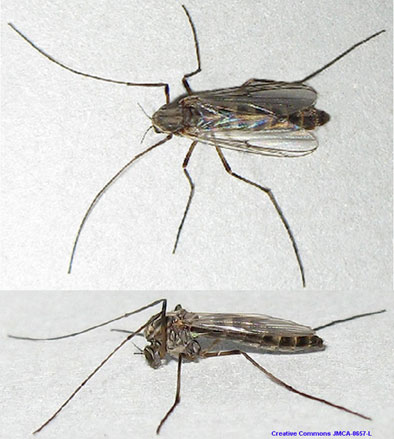| Fe
| Ti
| Ta1
| Ta2
| Ta3
| Ta4
| Ta5
| LR
| F/T
| Ta4/Ti
|
PI
| 900
| 780
| 1300
| 620
| 500
| 420
| 200
| 1.53-1.67
| 1.5
| 0.53
|
PII
| 930
| 850
| 530
| 300
| 200
| 150
| 100
| 0.62
| 1.09
| 0.18
|
PIII
| 1000
| 1070
| 800
| 470
| 330
| 200
| 120
| 0.75
| 0.93
| 0.19
|
Pupa Cephalothorax blackish; abdomen infuscate with marginal markings and swim fin blackish.
Total length 6.13-8.44 mm (males); (1 female Ð 8.70 mm), inner margin of wing case 1.92 mm. Respiratory base abt 139 x 80 µm and only slightly constricted in middle, although actual fibre base slightly constricted, patch with 3 vacuoles and 2 setae just anterior, also an area of scalloping slightly ventral; 55-74 recurved hooks at posterior margin of TII. Pedes spurii B visible on Seg. II, pedes spurii A on seg IV about 202-233 µm long and 233 µm wide (l/w 1.90) and about 0.27 of segment length; Pedes spurii A on segs V and VI just patches of spines. 65-74 Caudolateral spurs on segment VIII highly variable with from 1-6 spines, usually more than two, on a fairly broad base (except when only i spine). Swim fin with 57-85 flattened taeniae.
Fourth instar larva a small to medium (female 12.8 (10.2-14.2 mm; male 10.2 (1) mm.). thummi or plumosus-type (i.e. some from Truckee River with lateral projections up to about 60 µm long); posterior pair of ventral tubules usually longer - ant. 1.45 (0.92-2.08) mm; post. 1.60 (0.92-2.32) mm. Gular region and frontocylpeus pale. Anal tubules without a constriction, dorsal pair shorter and wider (347.2 (250-391) µm x 127. 0 (95-160) µm) than the ventral pair (393.0 (340-406) µm x 111.25 (100-120) µm). Oesophageal opening 61.8 (50.5-76.0) µm long, 18.6 (15.0-20.0) µm wide (2.9-5.0 times longer than wide). Ventral head length 290-370 µm.
Mentum (Fig. c) with pointed teeth; centre tooth tall and relatively narrow, side teeth well separated (type IB, occasionally type III); 4th laterals slightly reduced (type i-II).
Ventromentum (Fig. d) with smooth outer margin; about 43.6 (39-46) striae, about 185-215 µm wide, 3.3-3.6 times wider than deep; about 1.02-1.09 times wider than the mentum, VMR about 0.27-0.38. Pecten epipharyngis (Fig. a) with 13.9 (11-17) relatively broad, sharp teeth (type C).
Premandible (Fig. a) with relatively broad teeth, inner tooth about 4-6 times the outer tooth, inner coming to a broad point, the outer to a relatively narrow point.
Antenna (Fig. b) with basal segment about 0.37 (0.34-0.39) of the ventral head length and about 3.2 (3.0-3.5) times longer than wide and about 3.3 times longer than segment 2; Ring organ about 1/3 to 1/2 way up from base (although 3/4 in one antenna of one larva); AR about 1.92 (1.7-2.2); antennal proportions (micron) 118 ; 30.5 : 10 : 13 : 7.
Mandible (Fig. d) with 3rd inner tooth well developed and darkened (type IIIC); about 15.1 (13-18) furrows on outer surface near the base; about 12.3 (9-14) taeniae in Pecten mandibularis.
Cytology: 4 polytene chromosomes with the maturus arm combination AF, BE, CD, G.
Arm G normally paired except in the area of the subterminal nucleolus; two Balbiani rings whose position varies due to inversion polymorphism. No nucleoli in the long chromosomes.
Inversion polymorphism in arms B, C, D and G.
whiA1: 1a-e, 2d-3, 12-10, 2c-1f, 9-4, 15-13, 16-19; i.e. as maturus A2
whiB1: Puff with distal dark bands near the end of arm, but further from end than in maturus.
whiC1: 1-6b, 11c-8, 15-11d, 17a-16, 7-6c, 17b-22 ie. as aberratus, pilicornis, tenuistylus, etc.
whiC2: 1-2b, 11bc, 6b-2c, 11a-8, 15-11d, 17a-16, 7-6c, 17b-22
whiD1: 1-3g, 11-18d, 7-4, 10-8, 18g-24
whiE1: 1-3e, 10b-3f, 10c-13: i.e. as frommeri, halophilus, etc.
whiF1: 1-2, 15e-12d, 8-3, 9-12c, 15f-23
Molecular Data: Sequence for COI, CytB, and 18S given in Martin et al. (2007) (lodged in GenBank). Other COI sequences available in BOLD database.
Found: British Columbia - Abbotsford; Burnaby; Gulf Islands National Park Reserve; 10 Km w. Kamloops (all from BOLD)
California - horse trough, Santa Clara Co. (type locality); Berkeley, Alameda Co.; Kennsington, 2 ml. n. Lafayette, 1 ml s. Martinez, and
Wildcat Creek, El Cerrito, all Contra Costa Co.; Pico Rivera, Los Angeles Co., 12 ml ne. El Portal, Mariposa Co.;
6274 Western, Arlington, Experimental Ponds UCR, and 448 N. Orange St., both Riverside, all Riverside Co.;
Truckee River nr. Tahoe City (39.172°N, 120.138°W), Placer Co.; 5 ml n. Vacaville (38.37°N, 121.98°W), Solano Co.
Pools and shallow flowing parts of creeks and rivers. The sample from near Vacaville was in sulphurous water. Morphology described by Sublette and Sublette (1974), cytology by Wülker and Martin (1974), pattern of arm C1 in Wülker (1991) and of arm D1 in Kiknadze et al. (2004).
[ See also C. maturus| Return to Index| Go to References ]
